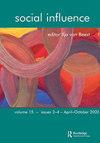变形和反社会惩罚
IF 0.6
3区 心理学
Q3 PSYCHOLOGY, SOCIAL
引用次数: 5
摘要
对公共产品的贡献使所有群体成员受益,但研究表明,慷慨的群体成员有时会受到惩罚。我们认为,当这种反社会惩罚是公开的,群体成员贡献的一致性将鼓励个体惩罚非典型慷慨的群体成员。同样,当群体成员的行为一致时,惩罚的公开性会增加反社会惩罚。对于那些有兴趣了解慷慨的偏差者的人来说,这两种影响都会减弱。我们在公共物品实验中检验我们的假设并找到支持。我们的发现有助于规范文献,特别是对反社会惩罚的理解。本文章由计算机程序翻译,如有差异,请以英文原文为准。
Metanorms and antisocial punishment
Abstract Contributions to public goods benefit all group members, yet research shows that generous group members are sometimes punished. We argue that when such antisocial punishment efforts are public, the consistency of group member contributions will encourage individuals to punish atypically generous group members. Similarly, when behavior of group members is consistent, the publicness of punishment will increase antisocial punishment. Both of these effects will be weaker for individuals who are interested in getting to know the generous deviant. We test our hypotheses in a public goods experiment and find support. Our findings contribute to the norms literature, in particular, to understanding of antisocial punishment.
求助全文
通过发布文献求助,成功后即可免费获取论文全文。
去求助
来源期刊

Social Influence
PSYCHOLOGY, SOCIAL-
CiteScore
1.50
自引率
0.00%
发文量
4
期刊介绍:
Social Influence is a journal that provides an integrated focus for research into this important, dynamic, and multi-disciplinary field. Topics covered include: conformity, norms, social influence tactics such as norm of reciprocity, authority, scarcity, interpersonal influence, persuasion, power, advertising, mass media effects, political persuasion, propaganda, comparative influence, compliance, minority influence, influence in groups, cultic influence, social movements, social contagions, rumors, resistance to influence, influence across cultures, and the history of influence research.
 求助内容:
求助内容: 应助结果提醒方式:
应助结果提醒方式:


